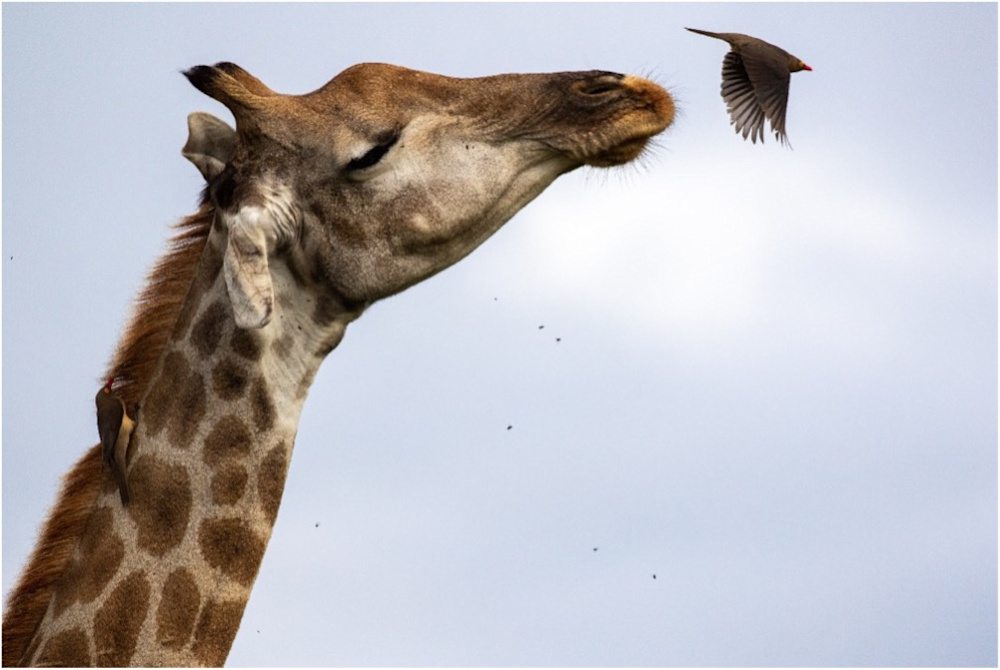May 2025
Biodiversity
Oxpeckers and their true role on herbivores: Symbiotic saviours or secret parasites?
in BiodiversityShare:
Oxpeckers and their true role on herbivores: Symbiotic saviours or secret parasites?
Oxpeckers (genus Buphagus) are often celebrated as the ultimate example of mutualism in the African savanna, small birds riding atop large herbivores like rhinos, buffaloes, and giraffes, feasting on ticks and parasites while providing a grooming service in return. But recent studies and behavioural observations suggest that this relationship is more complicated. This article explores the dual nature of oxpeckers and challenges the simplistic view of them as harmless symbionts.
Few images are more iconic in African wildlife than a red or yellow-billed oxpecker perched on the back of many herbivore species. These birds are often seen hopping around their host’s body, plucking off ticks and insects while the herbivore grazes unfazed. For decades, this behaviour was widely cited as a textbook example of mutualism, an interaction where both species benefit. But is the relationship really so harmonious?

Historically, oxpeckers (Buphagus erythrorhynchus and Buphagus africanus) were lauded for their apparent health benefits to their hosts. Feeding primarily on ectoparasites like ticks, these birds were thought to reduce parasite loads on large mammals. This idea was reinforced by the birds’ close association with herbivores and their apparent attentiveness to grooming. In this narrative, the herbivore benefits by getting rid of harmful parasites, while the oxpecker gets an easy meal, simple and symbiotic. However, recent research has complicated this view. Field observations and controlled studies have shown that oxpeckers often engage in behaviours that are detrimental to their hosts:
- Blood feeding: Oxpeckers don’t just eat ticks, they also peck at wounds and feed on blood, sometimes keeping wounds open for days to prolong their access to this resource.
- Wound maintenance: Some oxpeckers show a preference for already open wounds, returning to them repeatedly, which increases the risk of infection and delays healing.
- Parasitic balance: Studies have shown that oxpeckers don’t always reduce tick burdens significantly. In fact, they often prefer feeding on engorged ticks that are about to fall off anyway, offering minimal benefit to the host.
These behaviours place oxpeckers into a grey area between mutualism and parasitism. While they may still remove some parasites, the cost of their wound-exacerbating behaviours could outweigh the benefits.
Interestingly, not all herbivores tolerate oxpeckers equally. Some species, such as buffalos and giraffes, seem more permissive, perhaps due to their thick skin or the difficulty of grooming themselves. Others, like zebras, often actively shoo away oxpeckers or avoid them altogether. This variability suggests that the relationship may be more opportunistic than obligate and that host species weigh the costs and benefits differently.
So, are oxpeckers friends or foes? The answer lies somewhere in between. Their role appears to shift depending on the context, species of host, parasite load, presence of wounds, and individual bird behaviour.
In ecology, not all symbiotic relationships are black and white. The oxpecker-herbivore interaction is a prime example of a facultative mutualism with parasitic tendencies, a relationship that evolves along a continuum depending on ecological pressures and individual circumstances.
The story of the oxpecker reminds us that nature is rarely tidy. What once seemed like perfect mutualism now appears to be a more dynamic and nuanced interaction. Recognising this complexity is essential, not only for academic understanding but also for conservation efforts that aim to protect and manage these intricate ecological relationships.

By Damin Dallas
Field Guide


